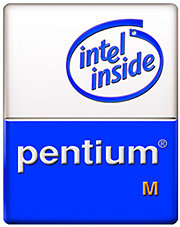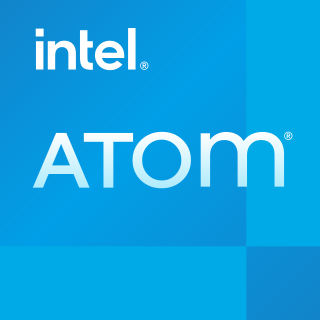
Hyper-threading is Intel's proprietary simultaneous multithreading (SMT) implementation used to improve parallelization of computations performed on x86 microprocessors. It was introduced on Xeon server processors in February 2002 and on Pentium 4 desktop processors in November 2002. Since then, Intel has included this technology in Itanium, Atom, and Core 'i' Series CPUs, among others.

In computing, overclocking is the practice of increasing the clock rate of a computer to exceed that certified by the manufacturer. Commonly, operating voltage is also increased to maintain a component's operational stability at accelerated speeds. Semiconductor devices operated at higher frequencies and voltages increase power consumption and heat. An overclocked device may be unreliable or fail completely if the additional heat load is not removed or power delivery components cannot meet increased power demands. Many device warranties state that overclocking or over-specification voids any warranty, however there are an increasing number of manufacturers that will allow overclocking as long as performed (relatively) safely.

The Pentium M is a family of mobile 32-bit single-core x86 microprocessors introduced in March 2003 and forming a part of the Intel Carmel notebook platform under the then new Centrino brand. The Pentium M processors had a maximum thermal design power (TDP) of 5–27 W depending on the model, and were intended for use in laptops. They evolved from the core of the last Pentium III–branded CPU by adding the front-side bus (FSB) interface of Pentium 4, an improved instruction decoding and issuing front end, improved branch prediction, SSE2 support, and a much larger cache. The first Pentium M–branded CPU, code-named Banias, was followed by Dothan. The Pentium M line was removed from the official price lists in July 2009, when the Pentium M-branded processors were succeeded by the Core-branded dual-core mobile Yonah CPU with a modified microarchitecture. It replaced the Mobile Pentium 4 processor, which suffered from power consumption and heat problems.
3DMark is a computer benchmarking tool created and developed by UL,, to determine the performance of a computer's 3D graphic rendering and CPU workload processing capabilities. Running 3DMark produces a 3DMark score, with higher numbers indicating better performance. The 3DMark measurement unit is intended to give a normalized means for comparing different PC hardware configurations, which proponents such as gamers and overclocking enthusiasts assert is indicative of end-user performance capabilities.

The Power Mac G5 is a series of personal computers designed, manufactured, and sold by Apple Computer, Inc. from 2003 to 2006 as part of the Power Mac series. When introduced, it was the most powerful computer in Apple's Macintosh lineup, and was marketed by the company as the world's first 64-bit desktop computer. It was also the first desktop computer from Apple to use an anodized aluminum alloy enclosure, and one of only three computers in Apple's lineup to utilize the PowerPC 970 CPU, the others being the iMac G5 and the Xserve G5.

UL Solutions is a global safety certification company headquartered in Northbrook, Illinois. It maintains offices in 46 countries. Established in 1894 as the Underwriters' Electrical Bureau, it was known throughout the 20th century as Underwriters Laboratories and participated in the safety analysis of many of that century's new technologies. As of 2022, the company has rebranded as UL Solutions.
The thermal design power (TDP), sometimes called thermal design point, is the maximum amount of heat generated by a computer chip or component that the cooling system in a computer is designed to dissipate under any workload.
Futuremark Oy was a Finnish software development company that produced computer benchmark applications for home, business, and press use. Futuremark was acquired by UL on 31 October 2014, and was formally merged into the company on 23 April 2018.

In computing, a benchmark is the act of running a computer program, a set of programs, or other operations, in order to assess the relative performance of an object, normally by running a number of standard tests and trials against it.
SPECint is a computer benchmark specification for CPU integer processing power. It is maintained by the Standard Performance Evaluation Corporation (SPEC). SPECint is the integer performance testing component of the SPEC test suite. The first SPEC test suite, CPU92, was announced in 1992. It was followed by CPU95, CPU2000, and CPU2006. The latest standard is SPEC CPU 2017 and consists of SPECspeed and SPECrate.

Microsoft XCPU, codenamed Xenon, is a CPU used in the Xbox 360 game console, to be used with ATI's Xenos graphics chip.
BAPCo, Business Applications Performance Corporation, is a non-profit consortium with a charter to develop and distribute a set of objective performance benchmarks for personal computers based on popular software applications and operating systems.
Intel oneAPI DPC++/C++ Compiler and Intel C++ Compiler Classic are Intel’s C, C++, SYCL, and Data Parallel C++ (DPC++) compilers for Intel processor-based systems, available for Windows, Linux, and macOS operating systems.

Larrabee is the codename for a cancelled GPGPU chip that Intel was developing separately from its current line of integrated graphics accelerators. It is named after either Mount Larrabee or Larrabee State Park in Whatcom County, Washington, near the town of Bellingham. The chip was to be released in 2010 as the core of a consumer 3D graphics card, but these plans were cancelled due to delays and disappointing early performance figures. The project to produce a GPU retail product directly from the Larrabee research project was terminated in May 2010 and its technology was passed on to the Xeon Phi. The Intel MIC multiprocessor architecture announced in 2010 inherited many design elements from the Larrabee project, but does not function as a graphics processing unit; the product is intended as a co-processor for high performance computing.

The VIA Nano is a 64-bit CPU for personal computers. The VIA Nano was released by VIA Technologies in 2008 after five years of development by its CPU division, Centaur Technology. This new Isaiah 64-bit architecture was designed from scratch, unveiled on 24 January 2008, and launched on 29 May, including low-voltage variants and the Nano brand name. The processor supports a number of VIA-specific x86 extensions designed to boost efficiency in low-power appliances.

Intel Atom is the brand name for a line of IA-32 and x86-64 instruction set ultra-low-voltage processors by Intel Corporation designed to reduce electric consumption and power dissipation in comparison with ordinary processors of the Intel Core series. Atom is mainly used in netbooks, nettops, embedded applications ranging from health care to advanced robotics, and mobile Internet devices (MIDs). The line was originally designed in 45 nm complementary metal–oxide–semiconductor (CMOS) technology and subsequent models, codenamed Cedar, used a 32 nm process.

Snapdragon is a suite of system on a chip (SoC) semiconductor products for mobile devices designed and marketed by Qualcomm Technologies Inc. The Snapdragon's central processing unit (CPU) uses the ARM architecture. A single SoC may include multiple CPU cores, an Adreno graphics processing unit (GPU), a Snapdragon wireless modem, a Hexagon digital signal processor (DSP), a Qualcomm Spectra image signal processor (ISP) and other software and hardware to support a smartphone's global positioning system (GPS), camera, video, audio, gesture recognition and AI acceleration. As such, Qualcomm often refers to the Snapdragon as a "mobile platform". Snapdragon semiconductors are embedded in devices of various systems, including Android, Windows Phone and netbooks. They are also used in cars, wearable devices and other devices. In addition to the processors, the Snapdragon line includes modems, Wi-Fi chips and mobile charging products.

Intel Core is a line of streamlined midrange consumer, workstation and enthusiast computer central processing units (CPUs) marketed by Intel Corporation. These processors displaced the existing mid- to high-end Pentium processors at the time of their introduction, moving the Pentium to the entry level. Identical or more capable versions of Core processors are also sold as Xeon processors for the server and workstation markets.
A browser speed test is a computer benchmark that scores the performance of a web browser, by measuring the browser's efficiency in completing a predefined list of tasks. In general the testing software is available online, located on a website, where different algorithms are loaded and performed in the browser client. Typical test tasks are rendering and animation, DOM transformations, string operations, mathematical calculations, sorting algorithms, graphic performance tests and memory instructions. Browser speed tests have been used during browser wars to prove superiority of specific web browsers. The popular Acid3 test is no particular speed test but checks browser conformity to web standards.
Kaby Lake is Intel's codename for its seventh generation Core microprocessor family announced on August 30, 2016. Like the preceding Skylake, Kaby Lake is produced using a 14 nanometer manufacturing process technology. Breaking with Intel's previous "tick–tock" manufacturing and design model, Kaby Lake represents the optimized step of the newer process–architecture–optimization model. Kaby Lake began shipping to manufacturers and OEMs in the second quarter of 2016, and mobile chips have started shipping while Kaby Lake (desktop) chips were officially launched in January 2017.











